Shep Hyken's Blog, page 137
November 16, 2018
Guest Blog: Impact of Technological Advancements on Consumer Behavior
This week we feature an article by Jim Iyoob who talks about how and why technology has changed consumer behavior and how you need to reinvent strategies to keep up with consumers. – Shep Hyken
As we all know, nowadays, consumer behavior is prejudiced by various aspects. With technological advancements, the market has seen a tremendous shift in consumer behavior. As a result of the technological impact influencing consumer behavior, most company leaderships face an unending challenge to meet consumer expectations. Because of the advent of information technology, consumer behavior seems to be more influenced by internet-enabled smartphones and tablets. Technology has literally placed the power in the consumer’s hands.
Today, a typical customer expects a prompt response and fast service from any business. To keep up with consumer expectations, all businesses are facing huge challenges. How and why has technology changed the way consumers behave? Here are a few things that you need to keep in mind as you reinvent your strategies to keep up with the consumers.
Customers are connected
Nearly everyone is living two lives, an energetic online life, and an exhausting disconnected one. We are altogether associated at some stage through our system of companions. We likewise claim in excess of one gadget that keeps us refreshed. This implies we blossom with being dynamic and educated on the web, and ExactTarget Marketing content confirmed this from a research they did, whereby 91% of purchasers demonstrated that access to content across all gadgets was imperative.
Data innovation progressions fuel the network that unites the world as one major network, from the advanced mobile phones to super-quick information. This pattern isn’t going to change since presently kids as youthful as 5 years know how to work a smartphone. LinkedIn even brought down its age breaking point to 13 years to gain on the technology adoption rate.
Organizations need to meet consumers where they are and fulfill their refined needs. On the off chance that your target market invests more energy in Instagram or Facebook or Twitter, be available and react to them on the same platform. Are you doing what’s necessary to use innovation and handle the educated customer?
Consumers Desires have changed
Before, as an organization, you set the times that you were open for business, and customers needed to endure it or remain without that specific product. Technology has completely changed that, with the introduction of online business and smartphones, customers can get to products whenever they want. They have raised desires on what is satisfactory consumer behavior and what isn’t. As a business, you need to stay aware of the changed buyer conduct or be bankrupt.
For instance, if a customer needs to buy something on the web during the evening and has a question, they hope to find prompt solutions. If they don’t they pick another provider from the countless accessible online who can meet their prompt needs.
Customers currently comprehend the power they have and will utilize it when not happy with an administration. A basic articulation of their disappointment on your social media that isn’t reacted to promptly will ignite uproar from different customers who approved of your products and services.
New correspondence channels
Previously, an organization gave customer service through emails – that did not get immediate reactions – and telephone calls. These two specialized devices had their own particular difficulties and favored the organization more; it was at their circumspection what data to give out.
This age nonetheless, is extremely revived. Social networking sites and live chat puts you directly before your customer; you can’t forfeit your customer to keep up your brand position. As a matter of fact, when you don’t react to a question, you harm your brand reputation since that data is available to a great many people.
The upside of these new devices is that you have a more extensive data gathering pool; you can quickly track your innovative work by using the big data. You should give customers choices and with alternatives that are tuned in to their ways of life and life stages, and worked to convey the quick, individual, and helpful customer service that they truly appreciate.
All in all, we have seen the development of technology and its effect on buyer conduct. We have taken a glimpse at three different ways that consumers conduct has changed, from associated customers to changing desires and new communication tools. I trust the declaration “Customer is the King” has never been experienced by organizations like in this information technology era.
Today customers know they are powerful and authoritative, what actions are you taking to extinguish their instant information thirst?
Jim Iyoob is the Chief Customer Officer for Etech Global Services. He has responsibility for Etech’s marketing, business development, program implementation and product development across all of Etech’s existing lines of business – Etech, Etech Insights, Etech Technology Solutions (ETS), and Etech Social Media Solutions.
For more articles from Shep Hyken and his guest contributors go to customerserviceblog.com.

Read Shep’s latest Forbes article: Industry Leader Secrets: Six Ways To Stand Out With Customer Experience
The post Guest Blog: Impact of Technological Advancements on Consumer Behavior appeared first on Shep Hyken.
November 14, 2018
How to Reduce Friction
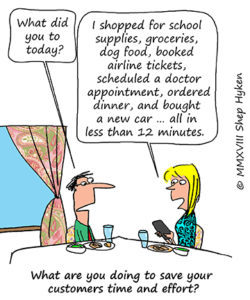 As most of you (hopefully know), my latest book, The Convenience Revolution, is all about making the customer experience as frictionless as possible. In the book, there are six Convenience Principles with plenty of examples, and many of our followers have read my articles and watched my videos on these powerful concepts. The other day I was interviewed and asked, “How does one get started?”
As most of you (hopefully know), my latest book, The Convenience Revolution, is all about making the customer experience as frictionless as possible. In the book, there are six Convenience Principles with plenty of examples, and many of our followers have read my articles and watched my videos on these powerful concepts. The other day I was interviewed and asked, “How does one get started?”
My flippant answer could have been, “Read the book and find out,” but instead I gave an answer that was simple and applicable to any type and any size business. Now, this is a very basic explanation of the process. It’s simple, but that doesn’t mean it’s easy. It’s where you want to start.
Identify touchpoints: First, start with mapping out every touchpoint your customer has with any aspect of your company. It can be an interaction on your website, a form they fill out, the checkout process, how they are greeted when they walk in your store or building, how the phone is answered, how the invoice is received, and much, much more. Every touchpoint must be identified.
Details count: Be as detailed as possible with every touchpoint. For example, if you sell from your website, how many steps does it take for a customer to check out? How many lines of information do they fill out? Get as detailed as possible.
Analyze each touchpoint: This is the fun part of the process. At each touchpoint, look for a way to reduce friction. Where can you eliminate a step? Where can you eliminate or reduce a customer’s effort? Is there any redundancy that can be eliminated? Can you deliver rather than make the customer come to you?
Execute: Now that you’ve identified (in great detail) and analyzed the touchpoints, you’re not finished until you take action.
Even the smallest reduction of friction counts. And, sometimes it makes you money. For example, the Wall Street Journal reduced friction by shortening their online checkout form. Some customers were not completing the checkout process. The WSJ experimented by shortening the process. Every unnecessary field removed from the checkout flow raised the conversion rate by as much as 1-3%.
Amazon all but eliminated the typical checkout process with their “Buy Now with 1-Click®” option. And, then they did one better with the Amazon Dash buttons. You push a button that looks like a doorbell and your product just shows up. I could imagine a group of smart Amazon employees sitting around the table answering the question, “I wonder if there is a way for our customers to order products without having to turn on their computer or open an app on their smartphone?” The result was Dash buttons.
The goal of reducing friction is to make the experience convenient and save the customer time. So, have a great product, offer great customer service and be more convenient. That’s a combination that is hard to beat.
Shep Hyken is a customer service expert, keynote speaker, and New York Times bestselling business author. For information, contact 314-692-2200 or www.hyken.com. For information on The Customer Focus customer service training programs, go to www.thecustomerfocus.com. Follow on Twitter: @Hyken
customer service training programs, go to www.thecustomerfocus.com. Follow on Twitter: @Hyken
(Copyright © MMXVIII, Shep Hyken)
The post How to Reduce Friction appeared first on Shep Hyken.
November 13, 2018
Amazing Business Radio: Dan Schawbel

Back to Human
How Great Leaders Create Connection In The Age of Isolation
Shep Hyken sits down with Dan Schawbel to discuss how to use technology as a bridge to a strong customer and employee connection.






Top Takeaways:
We are addicted and reliant on technology, so much that it gets in the way of building real human connections. Human connections matter.
Use technology to remove tedious tasks you don’t want to do, and let it lead you to places you can connect in a human way.
If you’re in a business meeting or networking event, put your technology away and be present with the people you’re with.
Customer service operations are increasingly reliant on technology to scale, save money and remove human error. This is a big mistake because the human touch will always be important, regardless of what technology does.
85% of the global workforce is disengaged. To engage your employees, create an experience where they do meaningful work with people who are supportive of them.
Consumers want options to connect with you and flexibility with how they interact with your company. You have to meet them where they are and how they want to interact with you. It’s less about you and more about them, their choices and how they want to do business.
You must be empathetic towards what customers and employees are going through. People are suffering and are challenged in many ways that you may not physically see.
Quotes:
“Let technology be a bridge to human connection instead of a barrier.” – Dan Schawbel
“If you’re in a business meeting or networking event, put your technology away and be present with the people you’re with.” – Dan Schawbel
“The human touch will always be important regardless of what technology does.” – Dan Schawbel
About:
Dan Schawbel is the research director of Future Workplace and managing partner of Millennial Branding. He’s also a keynote speaker and NYT bestselling author. His new book is Back To Human: How Great Leaders Create Connection In The Age Of Isolation.
Shep Hyken is a customer service and experience expert, New York Times bestselling author, award-winning keynote speaker, and your host of Amazing Business Radio.
This episode of Amazing Business Radio with Shep Hyken answers the following questions … and more:
Are companies too reliant on technology?
How can companies use technology to create a real human connection?
How can you connect with your employees and customers?
Why should you show more empathy for your employees?
The post Amazing Business Radio: Dan Schawbel appeared first on Shep Hyken.
November 12, 2018
5 Top Customer Service Articles for the Week of November 12, 2018
Each week I read a number of customer service and customer experience articles from various resources. Here are my top five picks from last week. I have added my comment about each article and would like to hear what you think too.
7-Eleven is testing new ‘scan-and-go’ technology by Ilyse Liffreing
(Digiday) 7-Eleven is making more moves to go cashierless — or at least give customers the option to. Starting Monday, 14 stores in Dallas will have scan-and-go technology built in the company’s mobile app, so customers can scan and pay for items on their phones.
My Comment: Amazon set the trend in motion with their version of a convenience store, known as Amazon Go. As we head toward “cashless retail,” other companies are stepping up, and one of them is 7-Eleven. This article will introduce you to 7-Eleven’s version of another way to deliver a more convenient customer experience.
What the modern gig economy is doing to customer experience by Dr. Chris Baumann
(CMO) Most marketing theory was established in the context of stable employment relationships. From front-line staff to marketing strategists and brand managers, employees generally enjoyed job security with classic benefits such as superannuation plans, stable income streams, employment rights, training, sabbaticals and long-service leave.
My Comment: The “gig economy” is a hot topic in the customer service world. Part-time (sub-contracted) employees are becoming more popular, allowing companies to staff-up when times are busy or go lean when business isn’t quite as busy. There are some benefits and concerns about how the gig-economy impacts customer service. This excellent article will give you insights you need to help determine if hiring a “gigger” will work for you.
4 Fixes for the Disconnect Between Marketing and the Customer Experience by Chris Wallace
(Chief Marketer) By 2020, the customer experience is expected to overtake price and product as a key brand differentiator. In other words, people will soon care more about how a company treats them than what they purchase or how expensive it is compared to competitors.
My Comment: Customer experience is marketing. The organizations that that know this reap the benefits of knowing what their customers expect and desire. And who better to tell you what your customers want than the people on the front line who interact with your customers every day. The author of this article shares four ideas to better connect your marketing efforts and CX efforts to your front line.
Predictions 2019: Customer Experience Comes Under Fire by Harley Manning
(Forrester) Let’s face it: 2018 was not a fabulous year for customer experience. On average, CX quality was flat, with Customer Experience Index (CX Index ) scores showing little movement for the third year in a row. And what little movement that did happen was toward the middle of our scale, where 62% of brands bunched up in an undifferentiated clump.
) scores showing little movement for the third year in a row. And what little movement that did happen was toward the middle of our scale, where 62% of brands bunched up in an undifferentiated clump.
My Comment: Just read Forrester’s CX predictions for 2019. In this excerpt from the report, Harley Manning, VP, Research Director shares three insights/predictions. Their information is always interesting and relevant.
Don’t Make Your Customers Do All The Work by Dan Gingiss
(Forbes) You can’t expect your customers to know everything. Yes, today’s customers are more connected and have access to more information than any other generation of customers in history, but they still can’t read minds (at least not yet). So why do many companies create situations where customers need to figure things out for themselves?
My Comment: My friend and fellow CX expert, Dan Gingiss, recognizes the importance of creating a convenient experience. Just as the title of this excellent article implies, don’t make your customers do all the work. The moment they experience friction with you and your products/services is the moment that plants the seed for them to do business with someone else the next time they need what you sell. Simply put, make it easy for them to do business with you.
 Shep Hyken is a customer service expert, professional speaker and New York Times bestselling business author. For information on The Customer Focus
Shep Hyken is a customer service expert, professional speaker and New York Times bestselling business author. For information on The Customer Focus customer service training programs go to www.TheCustomerFocus.com. Follow on Twitter: @Hyken
customer service training programs go to www.TheCustomerFocus.com. Follow on Twitter: @Hyken
The post 5 Top Customer Service Articles for the Week of November 12, 2018 appeared first on Shep Hyken.
November 9, 2018
Guest Blog: How Virtual Web Assistants Provide Productivity for Busy Companies
This week we feature an article by Andy Steuer who shares valuable information about how to use virtual web assistants to optimize productivity in areas of customer service, customer support, CRM management and more. – Shep Hyken
Developing and maintaining a successful enterprise in today’s demanding business landscape is no easy task. It’s no surprise then that when organizations begin to contemplate their future success and the resources required to support it, uncertainty can set in when deciding how to manage their growing infrastructures while maximizing their overall business productivity.
The fact of the matter is, as companies begin to scale, a lack of office space and restrictive full-time staffing budgets can cause hiccups in business development plans and significantly reduce departmental output. While these setbacks may be temporary for some organizations, most growing companies continuously struggle with the ability to focus on their forward progression while still managing their day-to-day operations. This is where the benefits of a virtual web assistant truly shine.
If you’re not familiar with the concept of using a virtual web assistant, consider how beneficial it would be to pass on busy assignments and day-to-day process to an experienced personal assistant, while you concentrate on higher-level department strategies and development. Virtual web assistants can quickly get up to speed with your organizational needs and can provide many productivity and cost-saving benefits for your company.
Here are several areas that virtual web assistants can optimize productivity for busy companies.
Customer Service
In nearly every organization, the customer service department is the life force that drives the success of the company, and maintaining that integrity is vital. Virtual web assistants can help to manage multiple levels of customer service interactions and workflows in an easy-to-manage on-demand staffing solution.
Support Tickets and CRM Management
Virtual web assistants can take the lead when managing support tickets and updates to CRM platforms such as Zendesk and Salesforce. By using a virtual resource to manage first-level support to customer inquiries and concerns, you can ensure your customers receive fast responses to their support issues and quicker resolutions. While maintaining CRM data accuracy can be time-consuming, a dedicated virtual web assistant can provide your customer information is always kept up to date, making it easier to track interactions over time and improve your overall engagement strategy. Helpware employs teams of virtual web assistants who are at your disposal and ready to streamline your customer service strategies
Email and Phone Support
As your company grows, so does the frequency of customer emails and phone inquiries. For organizations with demanding administrative workloads, employing dedicated staff members to answer phones and draft emails might not seem realistic. Virtual web assistants are an excellent solution for companies in need of a more personalized approach to their customer engagement strategy and can be trained to manage the customer experience entirely. By hiring a virtual workforce to handle any phone calls, email support, or live chat dialogues, you can ensure that your company maintains the highest level of customer service standards in your industry and surpasses industry benchmarks.
Order Management and Data Entry
Regardless of the size your of your organization, in one capacity or another, data entry processes can take up a considerable amount of your time and resources to manage day-to-day. Virtual web assistants are the perfect solution when looking for a way to automate the repetitive, but necessary aspects of your business operations.
Order Processing
Many companies find themselves in the position of wanting to automate their order entry processes, without significant investments in EDI (Electronic Data Interchange) to increase the productivity of their operational departments. At Helpware, their virtual web assistants can manage all of your necessary workloads to keep your organization running at optimal efficiency, including order processing, vendor portal management, and shipment tracking.
CRM and ERP Database Management
Whether you’re a small business or large-scale enterprise, maintaining database accuracy is essential for companies to optimize their operational performance and adequately represent their revenue and profitability. For many organizations, migrating to an ERP (Enterprise Resource Solution) is the most efficient way to manage all business transactions and inventory management is one centralized platform. However, properly maintaining these enterprise solutions takes a considerable amount of employee adoption and requires daily administrative workloads to manage. In cloud-based ERP solutions, virtual web assistants can be onboarded as administrators or regular users of these databases and free up a considerable amount of internal resources to manage them effectively. Virtual web assistants can help to monitor and maintain warehouse inventory levels, shipment tracking notifications, product return authorizations, and many other important aspects of database management.
Website Maintenance
When managing an E-commerce web presence, having dedicated staff to maintain your company website properly is essential. Not only is the functionality of your site relevant to the overall customer experience, but it is directly associated with the amount of revenue your organization brings in.
Product Listing Audits
Keeping your website up to date with your latest product offerings and inventory availability can be a time-consuming process. While there are many advanced CMS (Content Management Systems) like WordPress on the market today, finding enough time to manage these solutions effectively can be difficult. WordPress virtual assistants are a great way to automate the necessary website audits and updates to your product offerings on site, ensuring your website remains functional at all times while maximizing revenues.
Content Management
Most companies who maintain a web presence in today’s dynamic digital landscape understand the importance of regularly generating relevant content and distributing it through appropriate channels. At the fundamental level, most organizations maintain a corporate blog and regularly contribute to its development. However, periodically generating and organizing web content, whether through internal resources or outsourced freelance contractors, can be a full-time job on its own and extremely demanding of departmental bandwidth. Virtual web assistants can be employed as marketing assistants and digital content specialists that streamline the content management process, working with writing teams to ensure timely and accurate updates to company websites and blogs. This flexibility allows internal customer service, sales, and marketing teams to concentrate their efforts on improving the functionality of the site and maximizing the ROI of any content generation initiative.
Task Management
When companies put more of their focus into scaling their business processes, it becomes easy to lose track of all the steps necessary to keep managers and their departments organized and on task. Virtual web assistants can help fill the gaps in business productivity by providing on-demand solutions to task management and prioritization of assignments.
Calendar Scheduling
There are many different task management and personal assistant applications available on the market today that are designed to help employees manage their scheduling. In busy organizations though, these applications are rarely managed consistently and quickly become a wasted investment. Virtual web assistants, however, can not only handle these applications effectively, but they’re also able to provide personalized service in managing work schedules, essential event calendars, and staff functions.
Reporting and Email Follow Ups
While the importance of creating intelligent business reports and detailed company analysis is reasonably evident, having the time to review these reports and create actionable business strategies associated with them isn’t always achievable. Virtual web assistants make it possible for companies to achieve both of these initiatives. Companies can hand over all or a portion of any necessary reporting requirements to virtual web assistants while deploying standards for regularly scheduled updates and email follow-ups to support.
Virtual web assistants are the perfect solution for growing companies looking to improve their productivity while maximizing operational efficiencies. By investing in virtual staffing solutions to manage your customer service, website maintenance, and task management processes, you can ensure that your business maintains the highest productivity levels while reducing operational and staffing costs.
 Andy Steuer is the Co-Founder of
Helpware
where we help companies build their own enterprise-grade customer experience teams so they can earn more margin as they scale their businesses.
Andy Steuer is the Co-Founder of
Helpware
where we help companies build their own enterprise-grade customer experience teams so they can earn more margin as they scale their businesses.
For more articles from Shep Hyken and his guest contributors go to customerserviceblog.com.
Read Shep’s latest Forbes article:
The Ten Commandments Of Superior Customer Service

The post Guest Blog: How Virtual Web Assistants Provide Productivity for Busy Companies appeared first on Shep Hyken.
November 7, 2018
Be as Easy as Ordering a Pizza
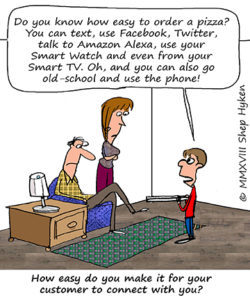 Back in my college days, I remember how easy it was at 11:00 at night, while studying for a test the next day, to order a pizza from Domino’s. I just picked up the phone and in less than thirty minutes, it was delivered. Today I do the same thing. I pick up the phone and order a pizza – but I don’t have to… pick up the phone.
Back in my college days, I remember how easy it was at 11:00 at night, while studying for a test the next day, to order a pizza from Domino’s. I just picked up the phone and in less than thirty minutes, it was delivered. Today I do the same thing. I pick up the phone and order a pizza – but I don’t have to… pick up the phone.
Technology has taken us to a new level of pizza ordering. Picking up a phone to order a pizza is an option, but it’s so old school. You can order online or use an app on your smartphone or tablet. Or, you can just use a voice command and order with Alexa or Google Home. And, once you order your pizza, you can track the order. You know when your pizza is being prepped when it comes out of the oven and when it’s on its way. Domino’s has made it easy – as in convenient.
And, if you’ve been following my work, you know about my fascination with convenience. I wrote the book, The Convenience Revolution, and identified six “Principles of Convenience,” one of them being delivery. I included Domino’s as a case study in the book, but guess what? I didn’t include them in the chapter on delivery. I included them in the chapter on technology.
In 2008 Domino’s was struggling and their brilliant leadership turned the company around. They recognized their pizza wasn’t as good as it could be, and publicly stated it needed improvement. So, they improved. They also revolutionized their process and started building technology into the customer experience. The Domino’s ANYWARE concept allows their customers to not only order the pizza with the toppings they desire but to connect with their neighborhood Domino’s by more than ten ways, with more to come. They include:
Google Home, Amazon Alexa, Slack, Facebook Messenger, Zero Clicks, Text, Twitter, Ford Sync, Smart TV, Voice and Smart Watch. And, of course, you can still order using the traditional “land-line” phone.
Consider that while some people still use the phone, a younger generation experienced these new apps as they were being released and have decided they don’t want to use the phone anymore. And an even younger generation has never ordered a pizza with a phone, and they simply won’t.
The point is that even a pizza company recognizes the necessity to reinvent its processes to keep up with the times. Beyond being a better pizza, they wanted to make it easier on their customers, and that’s what every company must do. Study what Domino’s has done. What are they doing that you can do in your business? What can you do to be more convenient for your customers?
Shep Hyken is a customer service expert, keynote speaker, and New York Times bestselling business author. For information, contact 314-692-2200 or www.hyken.com. For information on The Customer Focus customer service training programs, go to www.thecustomerfocus.com. Follow on Twitter: @Hyken
customer service training programs, go to www.thecustomerfocus.com. Follow on Twitter: @Hyken
(Copyright © MMXVIII, Shep Hyken)
The post Be as Easy as Ordering a Pizza appeared first on Shep Hyken.
November 6, 2018
Amazing Business Radio – Christa Heibel

Creating A Customer Experience Initiative
Owning Your Customer Service Initiative From the Top Down
Shep Hyken sits down with Christa Heibel to discuss the role the c-suite level plays in creating a CX strategy, how to keep track of your omnichannel presence, and how to measure and improve your customer experience strategy.






Top Takeaways:
Christa says she has yet to find a successful customer service initiative that didn’t involve the C-suite level. It starts with the leadership defining and driving the customer experience initiative and permeates through the entire organization.
Christa defines customer experience as any touchpoint between a brand, message, or logo and the consumer all the way through the sales, service, and support process.
One of the biggest consumer demands is turn around time. How quickly you respond to emails, answer phone calls, and ship products are all part of the customer experience.
You’ll see significant improvement and change to your customer experience initiative when the C-Suite gets involved from the beginning by creating priority, strategy, communication, expectations, and budget.
Your customer experience initiative is an ongoing process that must be measured and refined over time.
Omnichannel means offering the consumer their preferred channels and methods to communicate with your company. Customers expect companies they do business with to support communication through multiple channels.
Quotes:
It’s the C-suites job to drive, initiate, and own the customer experience initiative within an organization.” – Christa Heibel
“The entire organization is in charge of delivering the customer experience.” – Christa Heibel
“Figure out where your customers prefer to be and make sure that you’re there.” – Christa Heibel
“We used to set what the service levels were going to be. Now the consumer sets the expectations across every channel.” – Christa Heibel
About:
Christa Heibel is the founder of CH Consulting Group, a firm that helps organizations execute and implement contact center and customer experience strategies. For the last 25 years, Christa has dominated the contact center as an influencer and C-suite business growth and strategy expert.
Shep Hyken is a customer service and experience expert, New York Times bestselling author, award-winning keynote speaker, and your host of Amazing Business Radio.
This episode of Amazing Business Radio with Shep Hyken answers the following questions … and more:
Who should be in charge of delivering the customer experience?
How does the C-Suite create a strategy?
How do you budget for customer experience?
How do you track and measure your CX initiative?
Can you easily keep track of all of your channels?
The post Amazing Business Radio – Christa Heibel appeared first on Shep Hyken.
November 5, 2018
5 Top Customer Service Articles for the Week of November 5, 2018
Each week I read a number of customer service and customer experience articles from various resources. Here are my top five picks from last week. I have added my comment about each article and would like to hear what you think too.
The Secret Sauce to Customer Experience is a Blend of Four Ingredients by Joseph Michelli
(The Michelli Experience) Recently, a new client of mine said, “Just like everyone else I want to differentiate my business through the customer experiences I provide, but quite frankly I’ve tried a lot of things and am not seeing any sustained improvement.”
My Comment: Joseph Michelli is no stranger to the “Top Five” weekly roundup. This week he pens a short article on four “must do/have” customer service strategies: speed, convenience, knowledgeable help and friendly service. I’m glad he’s including convenience. That is what will turn a good customer experience into a great customer experience.
On Hold for 45 Minutes? It Might Be Your Secret Customer Score by Khadeeja Safdar
(WSJ) Retailers, wireless carriers and others crunch data to determine what shoppers are worth for the long term—and how well to treat them
My Comment: This is a fascinating article put out by The Wall Street Journal. You may have to sign in to read it, but it is well worth the extra effort. Imagine this: Two customers call for support at the same time. One is put on hold for 45 minutes and the other for 45 seconds. Why? Because these companies know who you are and have rated you on how much you spend, how much you complain and more.
21 Lessons From Jeff Bezos’ Annual Letters To Shareholders by CB Insights
(CB Insights) Each year, Jeff Bezos writes an open letter to Amazon’s shareholders. Over the last two decades, these letters have become an unparalleled source of insight into how the world’s richest man — and his company — think about customers, innovation, building products, and more.
My Comment: I’m always intrigued by anything I can learn from Jeff Bezos. For 21 years, he has written a letter to Amazon’s shareholders, which give you a glimpse into the way he thinks about customers, experience, innovation and much more.
Beating Bezos: Top online retailers like Rent the Runway are winning shoppers by offering what Amazon can’t by Eric Rosenbaum
(CNBC) The first step in online retail success: Accept there are some things that Amazon does that your company could never possibly compete with. Scope of product offering and price are big ones to concede to Jeff Bezos’ retail killer.
My Comment: As long as we’re on the topic of Jeff Bezos and Amazon (see Top Five article number three), here’s a great article about how to compete in the Amazon world. The secret? Don’t compete against Amazon. Do what Amazon doesn’t do.
Here’s Why Airlines DON’T Care About Customer Service by Kindra Cooper
(CCW Digital) Airlines seem to be above reproach when it comes to poor customer service, and the average air traveler knows it.
My Comment: This article is a bit controversial, in my opinion. I found it fascinating in that it is making the case for why airlines don’t care about delivering good customer service. That may appear to be the case with some airlines, but I’ll argue that it’s not true for all. That said, you’ll find it interesting, and it does close with an important statement: “And for those in the business of flying, know that your customers will always gravitate towards whatever is most convenient, and given the intensity of the competition, marginal differences in service can sometimes make a big difference.”
Shep Hyken is a customer service expert, professional speaker and New York Times bestselling business author. For information on The Customer Focus customer service training programs go to www.TheCustomerFocus.com. Follow on Twitter: @Hyken
customer service training programs go to www.TheCustomerFocus.com. Follow on Twitter: @Hyken
The post 5 Top Customer Service Articles for the Week of November 5, 2018 appeared first on Shep Hyken.
November 2, 2018
Guest Blog: How to Personalize Your Chatbots for Customer Journey Tracking & Provide a Better Experience
This week we feature an article by Catalin Corzini who shares information about how chatbots can provide a better experience and how to customize the customer journey when using chatbots. – Shep Hyken
We cannot escape the future. As we move towards big data and artificial intelligence, chatbots seem to be leading the way towards a more automated future. However, what people don’t realize is that it’s not only easy to start building a chatbot, but it has become a necessity for those who wish to maintain growth in a company. In this article, I’ll show you how you can harness the power of chatbots for your enhanced conversion rate optimization.
The Rise of Chatbots
Believe it or not, the chatbot has been around for a while now. It was in 1966 where Eliza, the first chatbot created by Joseph Weizenbaum, was first seen.
In 2010, the boys over at Apple released Siri that astounded the world because for the first time you had a super-commercial chatbot/personal assistant that was so easy to have the mass market adapt to.
Later, Google and Amazon were following suit capitalizing on the market demand of chatbots. Shortly, there were websites and businesses take advantage of the myriad of functionality that chatbots were providing to customers.
Chatbots have made artificial intelligence accessible to even the smallest of enterprises online, and it is no surprise that they are changing the landscape of digital marketing.
Uses of Chatbots
Chatbots have risen to prominence in almost every sector that needs to maintain a customer service front or any industry that maintains a database that would boost the customer experience if users had easy access to it.
It’s estimated that by 2022, the banking and healthcare sector will make savings of up to $8 billion with chatbot usage. That’s not all; there are numerous businesses that have been reporting claims of not only higher savings, but better revenue due to higher CTR and engagement from their customers. AI chatbots have been used in online retail websites as well as in healthcare, financial institutions and even in the government.
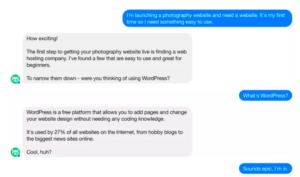 The Winnie Chatbot has even gotten a CTR of 72 percent after its appearance on the Facebook Messenger platform. Next Insurance was able to increase its rate of earnings 35-fold by good marketing and making their chatbot focus on small business owners.
The Winnie Chatbot has even gotten a CTR of 72 percent after its appearance on the Facebook Messenger platform. Next Insurance was able to increase its rate of earnings 35-fold by good marketing and making their chatbot focus on small business owners.
How You Can Utilize Chatbots to Guide Your Customers
There are indeed a lot of ways that you can harness the power of artificial intelligence in getting a chatbot that will maximize your efficiency, save on resources and provide a better customer experience.
A Personalized Guide to Help Out Your Customers
Imagine this scenario and I’m sure it’s happened to you before – a customer is on a landing page or website, and he does not know where to start.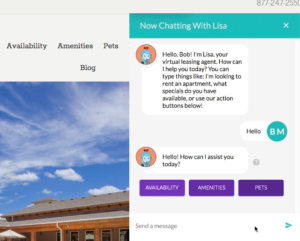
A bot can efficiently guide your customer through the website or through the products and services that you have.
Here’s one fact that you need to remember:
People love personalization. People love personalization so much that 71 percent of people will only like advertising that is customized for them. 
In application, it’s simple. You can use chatbots to provide a personalized experience for your customers, and this will, in turn, lead to better conversion rates. Bots can ask your potential customers questions that will fine-tune their experience with your site.
In retail, it’s the equivalent of having a merchandiser speaking with a customer and ensuring that they are getting what they need out of them.
 You can easily program a bot to ask a series of questions and given how the customer responds; it can use this data to provide a varied number of outputs that make sure that customers are being given personalized services.
You can easily program a bot to ask a series of questions and given how the customer responds; it can use this data to provide a varied number of outputs that make sure that customers are being given personalized services.
Another way of doing this is to have a persistent messenger bot at the bottom of the screen that tells the customer what to do or where to go to find things.
Tracking Buying Psychology
Bots retain information and in the world of sales, information is definitely powerful. Imagine a bot being an advanced cookie that can even track your customers’ buying behavior and export this information for future purposes such as retargeting.
The great thing about this sort of data is that you don’t even have to ask your customer directly, but phrase questions in such a conversational way.
Instantaneous Customer Service
This is one of the biggest uses of chatbots as of the moment. Instead of having your customer stay on hold for such a long time, you can get a bot to answer basic customer queries.
You can then connect your bot to one of your databases so that an employee does not have to manually input data to provide to the customer. Instead, it’s an automated process.
Say goodbye to waiting times for a customer’s queries to be answered.
Lead Qualification
Lead qualification can be an absolute pain but the good news about chatbots is that you can integrate a lead qualification function in them. While you’re in the process of guiding them through your web property, you can insert a few questions that can help qualify what sort of lead you’re tracking.
Even basic functionality such as tracking how many pages the user has visited can help qualify if a lead is “hot” or if you get your bot to ask if a user is comfortable with a particular pricing model that would be even better.
Using and Harnessing the Information That You Have
One of the most important things that most digital marketers often forget is that there is so much information that can be absorbed through a proper chatbot system.
This information should be harnessed in providing for a more intuitive customer experience.
Bots can provide valuable insights to a lot of things and if you were to take the data that you have gathered from your bots emphasizes a form of machine learning so to speak.
You can use the bulk of this conversation data to derive actionable insights as to how you provide a better form of customer service.
If you aren’t using chatbots yet, I suggest you do. The future is definitely automation.
Catalin Corzini is the founder of Ecommerce Platforms and Web App Meister. He’s a design enthusiast and loves matcha, and is uber passionate about blockchain technology and travel.
For more articles from Shep Hyken and his guest contributors go to customerserviceblog.com.

Read Shep’s latest Forbes Article: Five Ways Comcast Creates A World-Class Customer Experience
The post Guest Blog: How to Personalize Your Chatbots for Customer Journey Tracking & Provide a Better Experience appeared first on Shep Hyken.
October 31, 2018
Always Do Your Best
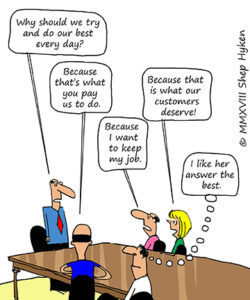 Our mantra at Shepard Presentations is to Always Be Amazing. Those three words are very important. They are totally consistent with what we stand for, what I write about in my books and articles, and how we conduct ourselves at work every day. It’s simple…
Our mantra at Shepard Presentations is to Always Be Amazing. Those three words are very important. They are totally consistent with what we stand for, what I write about in my books and articles, and how we conduct ourselves at work every day. It’s simple…
We want to be amazing for our employees.
We want to be amazing for our clients.
And, we want to teach our clients to be amazing to their customers, clients, guests, members – and anyone else they do business with.
Last year I wrote a book titled Be Amazing or Go Home. I wrote about the concept of consistency and used acting legend Richard Burton as an example. The focus was on consistently doing your best. Every day Burton tried to perform at his best. When he performed in plays, night after night, as he was walking out on stage, he would say, “I want to be so good tonight that I cheat the audience that was here last night.” In other words, be better today than yesterday.
That’s a lofty goal, but one worthy of trying to achieve. Maybe you do it. Maybe you don’t. Regardless, you give it your best shot. Often, it’s the effort of trying your best that gives others confidence about you. That’s what brings customers back – when they can say, “I can depend on them to always do what’s best.” And, if for some reason there is a failure, it won’t be for lack of effort.
That brings me to another example of doing your best. Sometimes you may need a reason. That reason can be your personal motivation. I recently read a quote by another legend, this time in the sports world. It is said that baseball icon and Hall of Famer, Joe DiMaggio, was asked by a reporter, “Why do you play so hard every single day?” Dimaggio replied, “Because in the stands there may be someone who is seeing me for the first time or for the last time, and they expect my best.”
Yes, DiMaggio was a fierce competitor and came to every game to win. And, it was his second reason that added fuel that motivation. Just like Richard Burton, Joe Dimaggio knew people came to see him play. They came to see him do his best. And, he never wanted to let them down.
So, what’s your reason for wanting to do your best? What inspires you to be the best you that you can be? When you find it, and you live it, you’ll come to work to be your best. Your customers will appreciate you. Your colleagues at work will appreciate you. And, you’ll appreciate you!
Shep Hyken is a customer service expert, keynote speaker, and New York Times bestselling business author. For information, contact 314-692-2200 or www.hyken.com. For information on The Customer Focus customer service training programs, go to www.thecustomerfocus.com. Follow on Twitter: @Hyken
customer service training programs, go to www.thecustomerfocus.com. Follow on Twitter: @Hyken
(Copyright © MMXVIII, Shep Hyken)
The post Always Do Your Best appeared first on Shep Hyken.



